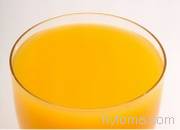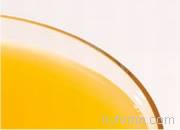 download article
download articleJuice
Article index
 | Juice production | |
 | 1. Juice extraction: cultivation and preparation | |
 | 2. Juice bottling: adjustment and bottling | |
 | Manufacturing different categories |
Juice production
Production is divided into two steps:1. Juice extraction: cultivation and preparation
The fruit is cleaned and sorted after harvesting. It is either prepared ready for dispatch as a consignment or, in the case of mass-produced goods such as orange juice, is directly concentrated locally in order to make optimum use of transport capacities. The other advantage of concentrated juice is that it requires less space and thus less refrigerating capacity.If the bottling plant is nearby, the juice can be bottled direct without using a concentration and redilution process.
The juice yield fluctuates between 40% and 85% of the fruit weight, depending on the fruit. The conductivity of juice ranges between 2.0 and 16.0 mS/cm. Juice extraction is a seasonal business: it is restricted to a few periods during the year. However, the full plant capacity has to be available during these periods. This places high demands on the technology. Stoppages may lead to spoiling of the fruit and subsequently to high losses. After the fruit arrives from the farm at the reprocessing company, it is subject to batch retracing and the HACCP control requirements of the end customer.
Once the concentrate has been produced, it must be preserved and documented in order to maintain the cooling chain up until final use.
2. Juice bottling: adjustment and bottling
The juice is adjusted in the bottling plant with water to the correct and usually its original concentration. It may be necessary to mix different batches in order to obtain a constant taste. Different fruit juices are also frequently mixed. Up to 15 grams of sugar, or even more in the case of some citrus fruits or citric acids, may be added. The added ingredients must be shown on the label.In order to fully preserve the juice with its contents, heat treatment to extend the shelf life is increasingly being dispensed with and bottling takes place in cold sterile systems. However, hot bottling (80-85°C) followed by recooling of the bottle is still used as the standard method. Bottling with hot product gives the bottle a heat treatment too, the chance of microbiological contamination due to the bottle is being reduced by this. Due to the high acidity of juice no spores can germinate, so sterilisation is not required and a heat treatment of upto 80 °C is sufficient to kill all vegetative microorganisms.
Manufacturing different categories
Products are manufactured in different categories:Direct juice: it is pressed and processed directly.
Juice: some of the water is removed from the juice for transportation and is added again to the same extent before bottling. No other ingredients are added. The quality of the juice only depends to a slight extent on whether not the end product contains fruit pulp.
Nectar: does not have the full juice content, only 25% to 40% is fruit juice. The product is diluted with more water than was removed from the original juice. Other ingredients are added at times.
Fruit juice drink: a fruit juice drink has more sugar than fruit juice as a basis. In this case the drink must only contain between 6% and 30% as fruit juice.
An increasing number of drinks containing a mixture of fruit juice and whey are being launched on the market.
 back to top
back to top






 companies
companies



